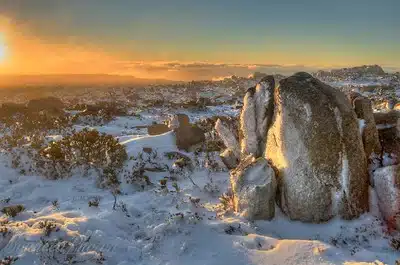Find Out About the Interesting Weather Patterns That Bring Snow In Australia Each Year
Find Out About the Interesting Weather Patterns That Bring Snow In Australia Each Year
Blog Article
Discover the Fascinating Effects of Snow in Australia on Local Communities
Despite its online reputation for sun-soaked landscapes, Australia also flaunts areas blanketed by snow-- a sensation that exceptionally affects the nation's special communities. The insulating residential or commercial properties of snowflakes secure plants and animals among the chilliest winter seasons, while the melting snow nurtures rivers and marine life. Nonetheless, the genuine wonder depend on how these icy conditions form the nation's biodiversity and nutrient cycles. As we decipher this complex partnership, we locate ourselves walking on unexplored premises in Australia's high country.
The Unforeseen Areas of Snowfall in Australia
Although Australia is commonly connected with sun-scorched landscapes and sandy beaches, specific areas surprisingly experience snowfall. The high nation areas of New South Wales, Victoria, and Tasmania are specifically recognized for their winter snow. The Snowy Hills in NSW, for example, receive bountiful seasonal snow, using a plain contrast to the country's regular hot, arid climate. At the same time, the Victorian Alps and parts of Tasmania also see yearly snowfalls, transforming the landscape into a winter months wonderland. These areas are not simply anomalies yet important components of Australia's varied climate system. The visibility of snow in these regions dramatically affects regional ecological communities, consequently impacting the nation's one-of-a-kind biodiversity. However, the details impact on Australia's distinct plants will be talked about in the next area.

How Snow Impacts Australia's Unique Plants
These plants have actually developed to endure in extreme problems, with snow offering as a protective blanket from extreme winds and freezing temperatures. The snow also contributes to the wetness web content of the soil, supplying required hydration for plant life during the dry summer season months. In essence, the snow influences the timing of blooming and seed dispersal, the development prices, and the survival of many plant species, showcasing the elaborate interplay in between environment and plants in Australia.

The Adjustments of Australian Fauna to Snowfall
Just as Australia's plants has adapted to the wintery conditions, the local fauna also, display remarkable adjustments to the snowfall. Types like the Mountain Pygmy-possum, the only Australian marsupial known to hibernate, have developed techniques to endure in snowy environments. It makes use of the snow as insulation, hibernating in rock crevices under the snow to stay warm. The Snow Skink, a types of reptile, alters its colour to white throughout wintertime, offering camouflage versus killers. Birds such as the Snowy Mountains' Crimson Rosella also change their diets to take in offered food resources throughout colder periods. Therefore, in spite of the severe problems, Australian animals shows a resistant and adaptive nature, ensuring their survival in areas experiencing snowfall.
The Duty of Snow fit Regional Environments
In forming the neighborhood communities, the function of snow in Australia is both multilayered and extensive. It affects the distribution of vegetation and fauna, greatly defining the biodiversity of alpine and sub-alpine areas. Snow supplies an essential water resource, feeding rivers and storage tanks as it melts, therefore sustaining a check my blog variety of marine life forms. Additionally, snow functions as an insulator, securing ground-dwelling organisms from extreme cold. It plays a substantial function in soil development and nutrient cycling. The routine cold and thawing of dirt caused by snowfall cultivates the break down of rocks, boosting dirt fertility. Subsequently, the visibility of snow forms the plant life patterns, animal habits, and total sustainability of Australia's unique communities. Does It Snow In Australia.

The Future of Snowfall in Australia: Forecasts and Ramifications

Provided the vital function snow plays fit local ecosystems, the future of snowfall in Australia is drawing boosting focus from environmentalists and scientists. Current climate designs forecast a considerable decline in snowfall because of global warming, with potentially profound effect on neighborhood ecological communities. Less snow could cause decreased water availability in alpine regions, adversely affecting wild animals environments and plant. It can change the timing of seasonal modifications, interfering with the life cycles of several native species. The tourism sector, greatly dependent on the winter snow period, might likewise face considerable challenges. Comprehending these forecasts and their ramifications is critical to create efficient preservation methods, ensuring the preservation of Australia's special biodiversity and the sustainability of its economic climate.
Final Thought
The role of snow in Australia's ecological communities is essential additional resources yet often overlooked. Thus, the snow in Australia is extra than a natural phenomenon; it's an essential player in the country's ecological story.
Despite its credibility for sun-soaked landscapes, Australia likewise boasts areas blanketed by snow-- a sensation that profoundly affects the nation's distinct communities. It utilizes the snow as insulation, hibernating in rock crevices underneath the snow to remain warm - Does Australia Get Snow.In forming the neighborhood ecosystems, the function of snow in Australia is both multilayered and extensive. The visibility of snow forms the greenery patterns, pet behavior, and overall sustainability of Australia's one-of-a-kind ecological communities
Provided the crucial duty snow plays in shaping regional environments, the future of snowfall in Australia is attracting boosting focus from environmentalists click this link and scientists.
Report this page